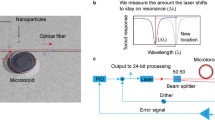Abstract
Modern sensors are becoming increasingly small in size while their sensitivity requirements remain relatively strict, to the point that the processing technology and test technology are highly difficult and costly. This paper proposes a micro-resonant biosensor with adjustable natural frequency. A positive feedback signal with a phase difference of 180 degrees is used to reduce the equivalent mass of the resonator, yielding an ultrahigh resonant frequency. The biosensor is formed by a coating bovine blood solution on the surface of the resonator of a cantilever sensor. The instantaneous frequency equation of the biosensor is established using a coupling dynamic calculation. The changes in instantaneous frequency during hemoglobin oxygen absorption and deoxygenation, are then measured. The proposed millimeter micro-resonant biosensor system measures the molecular weight of a single oxygen molecule quality at 5.7619×10−23 g, only deviating by 8.306 % from the theoretical value. Finally, the potential of the micron scale sensor is deeply taped.
Similar content being viewed by others
References
P. Li et al., Resonating frequency of a SAD circuit loop and inner microcantilever in a gas sensor, IEEE Sensors Journal, 10(2) (2010) 316–320.
P. Singh and R. D. S. Yadava, Effect of surface stress on resonance frequency of microcantilever sensors, IEEE Sensors Journal, 18(18) (2018) 1–1.
P. Yang, B. Chen and X. Wen, A novel MEMS chip-based atmospheric electric field sensor for lightning hazard warning applications, Sensors, IEEE Sensors (2015) 398–401.
W. Yuan, A review of silicon micromachined resonant pressure sensor, Journal of Mechanical Engineering, 49(20) (2013) 2–9.
Y. Zheng, Research progress and application prospect of smart sensor technology, Science and Technology Review, 34 (2016) 72–78.
Y. Shimizu and M. Egashira, Basic aspects and challenges of semiconductor gas sensors, Mrs Bull, 24(6) (2013) 18–24.
X. Fu and L. Xu, Multi-field coupled chaotic vibration for a micro resonant pressure sensor, Applied Mathematical Modelling, 72 (2019) 470–485.
A. D. L. Tamayo, A. M. Humphris and M. J. Malloy, Chemical sensors and biosensors in liquid environment based on micro-cantilevers with amplified quality factor, Ultramicroscopy, 86(1) (2001) 167–173.
J. Tamayo et al., High-q dynamic force microscopy in liquid and its application to living cells, Biophysical Journal, 81(1) (2001) 526–537.
G. Farbod et al., FPGA implementation of a low-cost method for tracking the resonance frequency and the quality factor of MEMS sensors, Sensors, IEEE (2012) 1–5.
P. Sangeetha and A. V. Juliet, Simulation of MEMS cantilever biosensor and analysis of readout methods for tuberculosis detection, Applied Mechanics and Materials, 376 (2013) 428–433.
L. F. Ma et al., A silicon resonant micro-cantilever biosensor with closed-loop self-excitation system for biomacromolecular detection, Advanced Materials Research, 1030–1032 (2014) 2320–2325.
J. Wang et al., A high accuracy cantilever array sensor for early liver cancer diagnosis, Biomedical Microdevices, 18(6) (2016) 110.
K. Waszczuk et al., Evaluation of pseudomonas aeruginosa biofilm formation using piezoelectric tuning fork mass sensors, Sensors and Actuators B: Chemical, 170 (2012) 7–12.
C. Chow et al., Development of sensitive and selective food sensors using new re(i)-pt(ii) bimetallic complexes to detect volatile biogenic sulfides formed by meat spoilage, Food Chemistry, 216 (2017) 382–389.
K. Jensen, K. Kim and A. Zettl, An atomic-resolution nanome-chanical mass sensor, Nature Nanotechnology, 3(9) (2008) 7–533.
K. I. Ekinci, Y. T. Yang and M. L. Roukes, Ultimate limits to inertial mass sensing based upon nanoelectromechanical systems, Journal of Applied Physics, 95(5) (2004) 2682–2689.
B. Iassagne, D. Garcia-Sanchez, A. Aguasca and A. Bachtold, Ultrasensitive mass sensing with a nanotube electromechanical resonator, Nano Letters, 8(11) (2008) 3735–3738.
X. Fu and L. Xu, Vibrations of a resonant gas sensor under multicoupled fields, Journal of Computational and Nonlinear Dynamics, 14(4) (2019) 041002.
L. Xu and X. Fu, A micro resonant gas sensor with adjustable natural frequency, IEEE Transactions on Industrial Electronics, 68(6) (2021) 5337–5345.
Acknowledgements
This project is supported by Natural Science Foundation of Hebei Province, China (E2021402024); Scientific research project of colleges and universities in Hebei Province, China (QN2022156); National Natural Science Foundation of China (52005148).
Author information
Authors and Affiliations
Corresponding author
Additional information
Conflicts of Interest
The authors declare that there are no conflicts of interest regarding the publication of this paper.
Xiaorui Fu is a lecturer in College of Mechanical and Equipment Engineering, Hebei University of Engineering, China. He received his Ph.D. in Mechanical Engineering from Yanshan University, China. His primary research interests are in the area of electromechanical coupled dynamics of the micro sensors system.
Ming Zhang is a Lecturer and Master Supervisor in School of Mechanical and Equipment Engineering, Hebei University of Engineering, China. He received his Ph.D. in Mechanical Design and Theory from Yanshan University, China. His research interests are mechanical system dynamics.
Rights and permissions
About this article
Cite this article
Fu, X., Zhang, M., Hou, D. et al. Molecular-resolution micro-resonant biosensor with adjustable natural frequency. J Mech Sci Technol 36, 5191–5199 (2022). https://doi.org/10.1007/s12206-022-0931-y
Received:
Revised:
Accepted:
Published:
Issue Date:
DOI: https://doi.org/10.1007/s12206-022-0931-y




